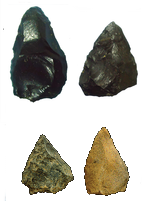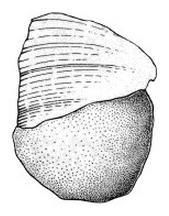Combining two tools with binding and glue (e.g. creating a spear out of a wooden shaft and stone tip) is known as “hafting.” This combined technology was an important development in our evolution, allowing our ancestors to make a greater variety of tools. The tools themselves were also more efficient, requiring less effort to do more work with. In fact some even speculate that hafting may even have changed our body! Over the past few hundred thousand years humans have become less muscley, perhaps because more efficient hafted tools meant we didn’t need as much strength before. In evolution, if you don’t use it you loose it.
Over the past week or so the press have been making a lot of fuss over 280,000 year old hafted spears from a place called Gademotta in Ethiopia. There they found obsidian tools which had microscopic damage. They recreated different tools with similar obsidian tips and used them, looking to see which produced similar damage. The researchers found it was most consistent with the tools being used as the tips of thrown spears1.

280,000 year old thrown spear tips (top) and 500,000 year old thrusting spear tips (bottom)
But despite all the media fuss, these aren’t actually the oldest hafted spears we know of. Another African site called Kathu Pan has yielded similar tools which are over 500,000 years old, making them almost double the age of the obsidian spears. Last year these ancient tools were subject to the similar tests (including being shot at a gazelle carcass with a crosbow. BECAUSE SCIENCE) and were also found to have damage consistent with being used as spears. However, the big difference is that these older tools appear to have been used as thrusting spears2; whereas the more recent ones were thrown spears.

“thrusting spears”
The Kathu Pan spears place the emergence of hafting and a critical moment in our evolution. Around this time the human family was beginning to split in two: a European branch that eventually became the Neanderthals and an African branch that evolved into us. We know both branches were capable of hafting. Humans produced the obsidian thrown spears, and we’ve found Neanderthal stone tools with the base caked in glue indicating it was hafted3. These ancient spears raise the possibility that hafting was a technology both branches inherited from their common ancestor, rather than invented independently.

Neanderthal tool with tar glue around the base
Since then the tools used by these two branches diverged, with the African group making this obsidian tipped throwing spears. Could this represent a cognitive change, with the ancestors of humans beginning to develop modern intelligence? Or maybe Neanderthals just didn’t like throwing. The famous wooden spears from Schoningen, Germany, were aerodynamic4 suggesting that the Neanderthal branch was not oblivious to the idea of throwing spears. Yet they still seem to have preferred the thrusting type. There’s evidence to suggest this is because of anatomical, rather than intellectual differences. Neanderthals had slightly different shoulders which would’ve meant they weren’t quite as good at throwing as us.
Either way, the fact remains that we started from the same point but our technology began to diverge. Perhaps this is one reason why we are the last of our kind whilst the Neanderthals died out. If so, its interesting to note that this key development was not a new invention but just a new way of using an existing tool.
References
- Sahle, Y., Hutchings, W. K., Braun, D. R., Sealy, J. C., Morgan, L. E., Negash, A., & Atnafu, B. (2013). Earliest Stone-Tipped Projectiles from the Ethiopian Rift Date to> 279,000 Years Ago. PloS one, 8(11), e78092.
- Wilkins, J., Schoville, B. J., Brown, K. S., & Chazan, M. (2012). Evidence for early hafted hunting technology. Science, 338(6109), 942-946.
- Mazza, P. P. A., Martini, F., Sala, B., Magi, M., Colombini, M. P., Giachi, G., … & Ribechini, E. (2006). A new Palaeolithic discovery: tar-hafted stone tools in a European Mid-Pleistocene bone-bearing bed. Journal of Archaeological Science, 33(9), 1310-1318.
-
Balter, Michael 2009. On the Origin of Art and Symbolism. Science 323:709-711.

